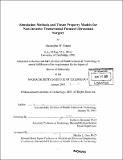Simulation methods and tissue property models for non-invasive transcranial focused ultrasound surgery
Author(s)
Connor, Christopher W
DownloadFull printable version (19.45Mb)
Other Contributors
Harvard University--MIT Division of Health Sciences and Technology.
Advisor
Kullervo Hynynen.
Terms of use
Metadata
Show full item recordAbstract
Many brain tumors are localized deeply and are currently surgically inaccessible without causing severe damage to the overlying structures of the brain. The current spectrum of non-invasive methods for treating such tumors includes radiotherapy, which requires exposure to ionizing radiation, and chemotherapy, which is systemically toxic. However, these tumors may also potentially be attacked by focusing highly intense ultrasound onto them. Focused ultrasound surgery is without the side effects of radiotherapy and chemotherapy, and the therapeutic effect of ultrasound therapy can be monitored in real- time using the proton chemical shift MRI technique. However, in order for brain tumors to be treated non-invasively, the ultrasound must be focused onto the targeted brain tissue through the intact cranium. Transcranial focusing of ultrasound is a longstanding and difficult problem as skull is a highly heterogeneous material. As the ultrasound field propagates through the bones of the skull, it undergoes substantatial distortion due to the variations in density and speed of sound therein. There is substantial individual variation in skull size, thickness and composition. Furthermore, the acoustic attenuation coefficient in bone is high, so the skull may also be heated by the ultrasound propagating through it. This thesis contains novel simulation techniques for analyzing transcranial acoustic propagation and for analyzing the temperature changes so produced in the brain, skull and scalp. These techniques have also been applied to modeling non-invasive treatment of the liver, and to producing therapeutic ultrasound fields that harness non-linear acoustic effects advantageously. (cont.) The thesis also contains unified models for the speed of sound and the acoustic attenuation coeffiecient in human skull. These models were generated by combining genetic optimization algorithms, acoustic propagation modeling and empirical measurement of intracranial ultrasound fields; they are valid across the full range of trabecular and cortical cranial bone.
Description
Thesis (Ph. D.)--Harvard-MIT Division of Health Sciences and Technology, 2005. Includes bibliographical references.
Date issued
2005Department
Harvard University--MIT Division of Health Sciences and TechnologyPublisher
Massachusetts Institute of Technology
Keywords
Harvard University--MIT Division of Health Sciences and Technology.